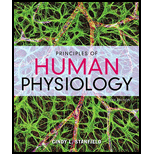
Introduction:
Sensory neurons are the nerve cells in the nervous system that works to convert signals from the external environment to the internal stimuli. They are also termed as afferent neurons, as they transfer the signals from the various parts of the body to the central nervous system.
Answer to Problem 1E
Solution:
The correct answer is option (b) the somatosensory cortex.
Explanation of Solution
Explanation/justification for the correct answer:
Option (b) is the somatosensory cortex. Touch perception is processed by the somatosensory system. This system includes the sensory receptors, peripheral sensory neurons, and brain cells. Hence, this option is correct.
The explanation for the incorrect answer:
Option (a) is the basal nuclei. The basal nuclei are the region at the base of the brain, which includes the clusters of neurons or nerve cells. This portion is responsible for the movement and coordination of the body. Hence, this option is incorrect.
Option (c) is the hypothalamus. The main function of the hypothalamus is to secrete hormones and controlling the
Option (d) is the limbic system. The functions of the limbic system include motivation, emotion, learning, and memory. Hence, this option is incorrect.
Option (e) is the hippocampus. It is an important organ of the limbic system. It is basically associated with long-term memory. Hence, this option is incorrect.
Touch perception requires that sensory neurons from the skin transmit information to the somatosensorycortex. Hence, option (b) is correct.
Want to see more full solutions like this?
Chapter 9 Solutions
Principles of Human Physiology Plus Mastering A&P with Pearson eText - Access Card Package (6th Edition)
 Human Anatomy & Physiology (11th Edition)BiologyISBN:9780134580999Author:Elaine N. Marieb, Katja N. HoehnPublisher:PEARSON
Human Anatomy & Physiology (11th Edition)BiologyISBN:9780134580999Author:Elaine N. Marieb, Katja N. HoehnPublisher:PEARSON Biology 2eBiologyISBN:9781947172517Author:Matthew Douglas, Jung Choi, Mary Ann ClarkPublisher:OpenStax
Biology 2eBiologyISBN:9781947172517Author:Matthew Douglas, Jung Choi, Mary Ann ClarkPublisher:OpenStax Anatomy & PhysiologyBiologyISBN:9781259398629Author:McKinley, Michael P., O'loughlin, Valerie Dean, Bidle, Theresa StouterPublisher:Mcgraw Hill Education,
Anatomy & PhysiologyBiologyISBN:9781259398629Author:McKinley, Michael P., O'loughlin, Valerie Dean, Bidle, Theresa StouterPublisher:Mcgraw Hill Education, Molecular Biology of the Cell (Sixth Edition)BiologyISBN:9780815344322Author:Bruce Alberts, Alexander D. Johnson, Julian Lewis, David Morgan, Martin Raff, Keith Roberts, Peter WalterPublisher:W. W. Norton & Company
Molecular Biology of the Cell (Sixth Edition)BiologyISBN:9780815344322Author:Bruce Alberts, Alexander D. Johnson, Julian Lewis, David Morgan, Martin Raff, Keith Roberts, Peter WalterPublisher:W. W. Norton & Company Laboratory Manual For Human Anatomy & PhysiologyBiologyISBN:9781260159363Author:Martin, Terry R., Prentice-craver, CynthiaPublisher:McGraw-Hill Publishing Co.
Laboratory Manual For Human Anatomy & PhysiologyBiologyISBN:9781260159363Author:Martin, Terry R., Prentice-craver, CynthiaPublisher:McGraw-Hill Publishing Co. Inquiry Into Life (16th Edition)BiologyISBN:9781260231700Author:Sylvia S. Mader, Michael WindelspechtPublisher:McGraw Hill Education
Inquiry Into Life (16th Edition)BiologyISBN:9781260231700Author:Sylvia S. Mader, Michael WindelspechtPublisher:McGraw Hill Education





